Policy paradox under the wave of de-dollarization: Why does Trump allow the dollar hegemony to loosen?
- 2025年4月3日
- Posted by: Macro Global Markets
- Category: News

On April 2, 2025, the Trump administration will officially launch the "Global Reciprocal Tariff" plan, imposing a 25% tariff on imported cars and plans to implement comprehensive tariffs on all trade deficit countries. This policy has already caused a stir in the global financial market. The US dollar index fell 0.3% to 104.12 today. Although spot gold closed down 0.02% to $3,110.95 per ounce, it once hit a record high of $3,148 during the session. The market's concerns about the stability of the US dollar system have intensified, and behind the Trump administration's "selective blindness" lies a deeper strategic consideration.

1. The collapse of the petrodollar system
Since Saudi Arabia terminated the petrodollar agreement with the United States in June 2024, it has gradually adopted RMB settlement in its oil trade with China. In March 2025, the proportion of RMB settlement in the long-term supply contract signed between Saudi Aramco and Sinopec increased to 35%. This change broke the pattern of oil trade centered on the US dollar since 1974, and promoted the transformation of global energy trade to multi-currency settlement.
2. The “infrastructure revolution” of RMB internationalization
The RMB Cross-Border Payment System (CIPS) led by the People's Bank of China has covered 182 countries and regions in 2023, with 119 direct participants and 1,362 indirect participants. In 2024, the amount of business processed by CIPS reached 96.7 trillion yuan, a year-on-year increase of 21.48%. The improvement of this system provides technological support for scenarios such as "petro-RMB" and "mineral-RMB", and weakens the monopoly of the US dollar in international trade.
3. Geopolitically driven monetary restructuring
After the Russia-Ukraine conflict, Russia converted 40% of its foreign exchange reserves into gold and established ruble-ruble and lira-ruble settlement mechanisms with India, Turkey and other countries. Middle Eastern countries are accelerating their gold holdings. The UAE Central Bank will increase its gold reserves by 28% year-on-year in 2024, and the Qatar Central Bank will increase its holdings by 15 tons. This "gold + local currency" reserve strategy is shaking the foundation of the US dollar as a global safe-haven asset.

1. The “double-edged sword” effect of tariff policy
Although Trump's tariff policy is aimed at protecting the US manufacturing industry, it has accelerated the global de-dollarization process. Spanish Prime Minister Pedro Sanchez warned on March 28 that if the US imposes tariffs on the EU, the EU will take "swift and consistent retaliatory measures." This trade confrontation has forced companies to seek alternative currency settlements. For example, Volkswagen has negotiated with Chinese suppliers to settle some parts purchases in euros.
2. The “hidden line” between fiscal deficit and gold reserves
The Trump administration is considering easing fiscal pressure by revaluing gold reserves. The 8,133 tons of gold held by the U.S. Treasury Department is worth about $760 billion at current market prices, while official accounting still uses the 1973 standard of $42 per ounce. If the pricing rules are adjusted, the Treasury Department's assets can be directly increased by $750 billion. This "gold monetization" strategy is essentially an indirect hedge against the risk of a depreciating dollar by enhancing the status of gold.
3. The game between inflation and interest rate cut expectations
Although the US ISM manufacturing PMI shrank to 49 in March and the PCE price index rose by 2.8% year-on-year, exceeding expectations, the market still bets that the Fed will cut interest rates in June, and CME data shows that the probability of a rate cut is 76%. The 10-year US bond yield fell back to 4.366%, and the US dollar was suppressed, thereby pushing up the price of gold denominated in US dollars. Trump's "acquiescence" to the depreciation of the US dollar is essentially to stimulate exports through a weak US dollar and reserve space for debt monetization.

1. Policy Tipping Point
If Trump imposes "undifferentiated tax increases" on allies such as the EU and Japan in the tariff details announced on April 2, it may trigger a joint sell-off of U.S. debt by the G7 countries. In 2024, Japan has reduced its holdings of U.S. debt by $120 billion and Germany has reduced its holdings by $80 billion. This "de-dollarization sell-off" will aggravate the dollar liquidity crisis.
2. The logic of gold’s “de-anchoring”
When the dollar reserve ratio drops from the current 59% to below 50%, gold may be upgraded from a "safe haven asset" to an "alternative currency". In February 2025, the Reserve Bank of India allowed rupee-gold swap transactions. This "gold monetization" innovation foreshadows the embryonic form of a new international monetary system.
When the dollar reserve ratio drops from the current 59% to below 50%, gold may be upgraded from a "safe haven asset" to an "alternative currency". In February 2025, the Reserve Bank of India allowed rupee-gold swap transactions. This "gold monetization" innovation foreshadows the embryonic form of a new international monetary system.
